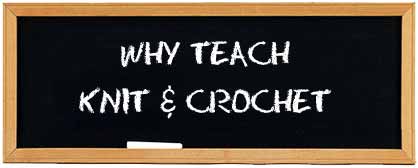 Learning to knit and crochet is fun, creative and benefits children in a variety of ways. With the current popularity of these crafts and the variety of yarns and cool projects available, it's also easy to interest them in learning, and is a cost-effective program. As many teachers and doctors attest, improvement is noted in:
Learning to knit and crochet is fun, creative and benefits children in a variety of ways. With the current popularity of these crafts and the variety of yarns and cool projects available, it's also easy to interest them in learning, and is a cost-effective program. As many teachers and doctors attest, improvement is noted in:
- Fine motor coordination
- Reading
- Math
- Comprehension
- Critical thinking and problem-solving
In addition, knitting and crochet are valuable tools for "teaching life lessons":
- Responsibility—Students are responsible for bringing their yarn project to class
- Ability to focus and follow through—Learning these skills is a step-by-step process
- Persistence—Projects take time and patience to complete
- Positive social behaviors and teamwork—Projects such as Warm Up America! require a group to work together to accomplish their goal
- Using available materials—Challenge students to be creative with the materials they have to work with
- Personal hygiene—Students quickly learn dirty hands mean dirty yarn
Judith Symonds and Cat Bordhi also mention Dr. Howard Gardner's Multiple Intelligences (MI) teaching approach to better understand their reasons for incorporating these skills in their curricula. Gardner, a psychologist and neuroscientis, is the Hobbs Professor of Cognition and Education at Harvard Graduate School of Education. His MI theory "challenges traditional beliefs in the fields of education and cognitive science," recognizing that there are many different ways of learning and there are benefits to more actively involving children in the learning process. Gardner outlines nine different kinds of intelligence through which people learn to effectively contribute to society and to develop skills that solve problems. Among his nine points is "Bodily/Kinesthetic Intelligence," the capacity to use your whole body or parts of your body (your hands, your fingers, your arms) to solve a problem, or make something…" Knitting and crochet, which engage both hands, are examples. Gardner's multiple approaches to learning are also reflected in key findings from The Academic Value of Hands-on Craft Projects in Elementary Schools conducted by Rockman Et Al, an independent education research and consulting company for the Craft and Hobby Foundation. They support the benefits of this type of learning. Among the findings were:
- 96% of teachers agreed that students exhibit greater curiosity about the learning unit when hands-on projects are included in the instructional approach.
- 90% of teachers said that hands-on projects help students understand basic ideas as well as broader concepts.
- 85% of the teachers said students work cooperatively on handcrafted projects.
- 82% of teachers said that handcrafts projects help their students apply information in new or different situations.
- 54% of teachers said this approach is particularly well suited for students who learned more effectively in non-traditional approaches, such as visual or kinesthetic learners, slow readers or writers, or non-native English speakers.
